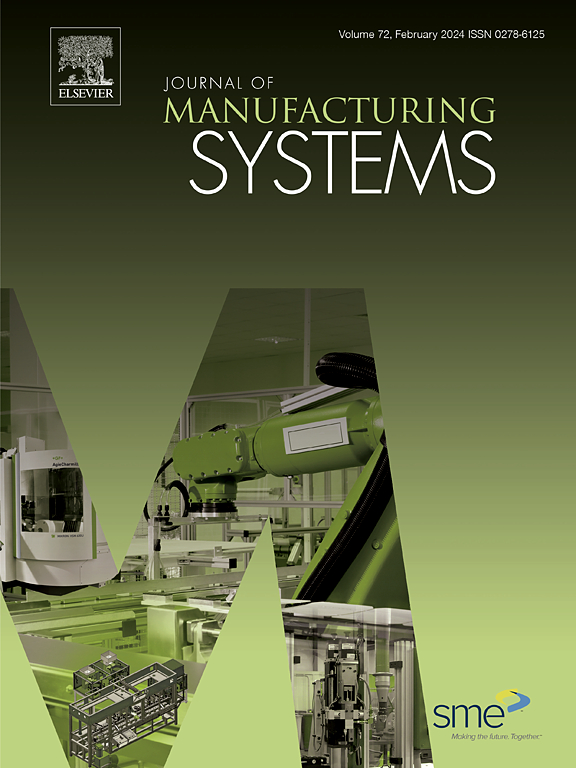具有双功能机器人和跳站作业的环形布局多工位多机器人焊接系统的集成调度
IF 12.2
1区 工程技术
Q1 ENGINEERING, INDUSTRIAL
引用次数: 0
摘要
机器人自动化生产是现代汽车工业大规模生产的最佳选择。机器人焊接系统的集成优化是实现高效生产的关键。目前的研究主要针对基本生产线的有限集成子问题。研究了多工位多机器人生产线中复杂耦合问题的集成调度问题。全面研究了机器人分配、任务分配、双功能机器人调度、人机协同工作和焊接顺序规划等紧密耦合子问题,并建立了模型,考虑了生产线组成和零件装配中的众多约束条件。同时,对机器人跳跃站的操作问题也进行了研究。这些具有众多约束条件的复杂耦合问题被整合到一个统一的、新颖的综合调度框架中。在此基础上,建立了考虑机器人可达性、焊接可达性、焊接完整性和工艺可行性约束的综合调度模型,并提出了一种算法对模型中的问题进行优化。针对多工位多机器人焊接系统集成调度问题,设计了一种包含两个隐藏层的五层染色体来表示决策空间。为了保证机器人在进化过程中的可达性和焊接完整性,设计了一种染色体校正方法。最后,在四个测试实例组中,将所提出的STNSGA-DFC与五种多目标进化算法(moea)进行了比较。实验结果表明,STNSGA-DFC在整体性能上优于比较算法。本文提出的模型和优化方法对提高工业环境下的批量生产效率具有重要的潜力,对复杂耦合焊接系统的集成优化具有重要的实用价值。本文章由计算机程序翻译,如有差异,请以英文原文为准。
Integrated scheduling for ring layout multi-station multi-robot welding system with dual function robots and jump stations operations
Robotic automated production is the best choice for large-scale manufacturing in the modern automotive industry. Optimizing robotic welding system in an integrated manner is crucial to achieving efficient production. Current research primarily addresses the limited integration of sub-problems for basic production lines. The integrated scheduling of complex coupling challenges in multi-station multi-robot production line is explored in this paper. Tightly coupled sub-problems such as robot allocation, task allocation, dual-function robot scheduling, human–robot cooperative work and welding sequence planning are comprehensively studied and modeled, accounting for numerous constraints in production line composition and parts assembly. Meanwhile, the issue of robot jumping stations operate is also investigated. These complex coupled problems with numerous constraints are incorporated into a unified and novel comprehensive scheduling framework. On this basis, an integrated scheduling model considering robots accessibility, welding accessibility, welding integrity and process feasibility constraints is established, along with an algorithm is proposed to optimize the problems in the model. A five-layer chromosome, featuring two hidden layers, is designed to represent the decision space of the multi-station multi-robot welding system integrated scheduling (MSMRWS-IS) problem. To ensure robot accessibility and welding completeness during evolution, a chromosome correction method is devised. Finally, the proposed STNSGA-DFC is compared with five multi-objective evolutionary algorithms (MOEAs) across four test instance groups. The experimental results demonstrate that STNSGA-DFC outperforms the comparison algorithms in terms of overall performance. The model and optimization method presented in this paper offer significant potential for improving mass production efficiency in industrial environments and hold significant practical value for the complex coupled welding system integrated optimizing.
求助全文
通过发布文献求助,成功后即可免费获取论文全文。
去求助
来源期刊

Journal of Manufacturing Systems
工程技术-工程:工业
CiteScore
23.30
自引率
13.20%
发文量
216
审稿时长
25 days
期刊介绍:
The Journal of Manufacturing Systems is dedicated to showcasing cutting-edge fundamental and applied research in manufacturing at the systems level. Encompassing products, equipment, people, information, control, and support functions, manufacturing systems play a pivotal role in the economical and competitive development, production, delivery, and total lifecycle of products, meeting market and societal needs.
With a commitment to publishing archival scholarly literature, the journal strives to advance the state of the art in manufacturing systems and foster innovation in crafting efficient, robust, and sustainable manufacturing systems. The focus extends from equipment-level considerations to the broader scope of the extended enterprise. The Journal welcomes research addressing challenges across various scales, including nano, micro, and macro-scale manufacturing, and spanning diverse sectors such as aerospace, automotive, energy, and medical device manufacturing.
 求助内容:
求助内容: 应助结果提醒方式:
应助结果提醒方式:


